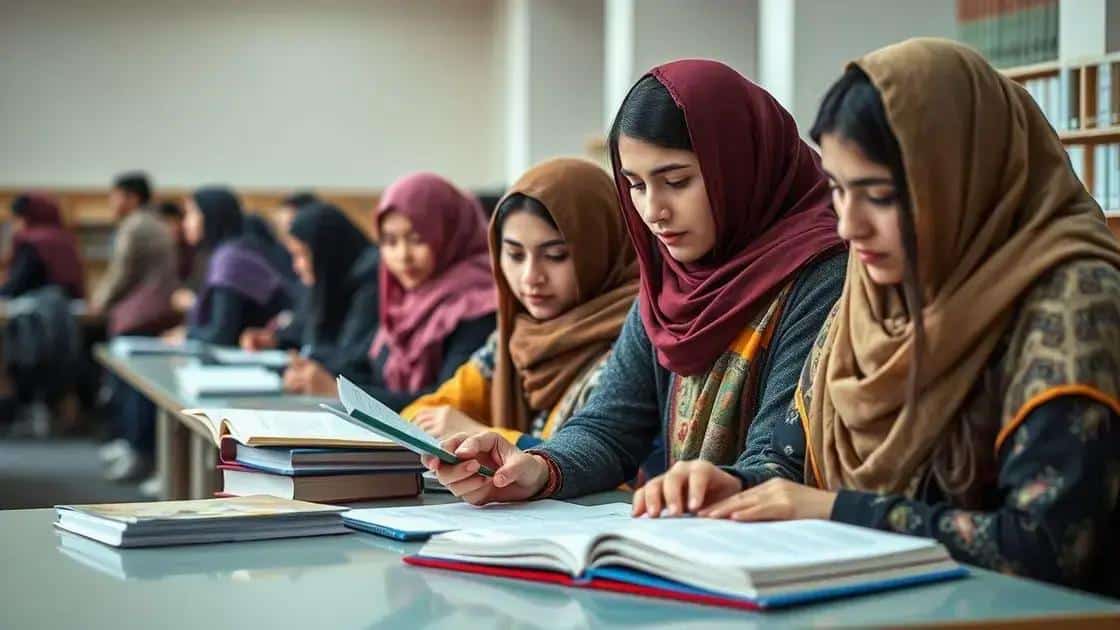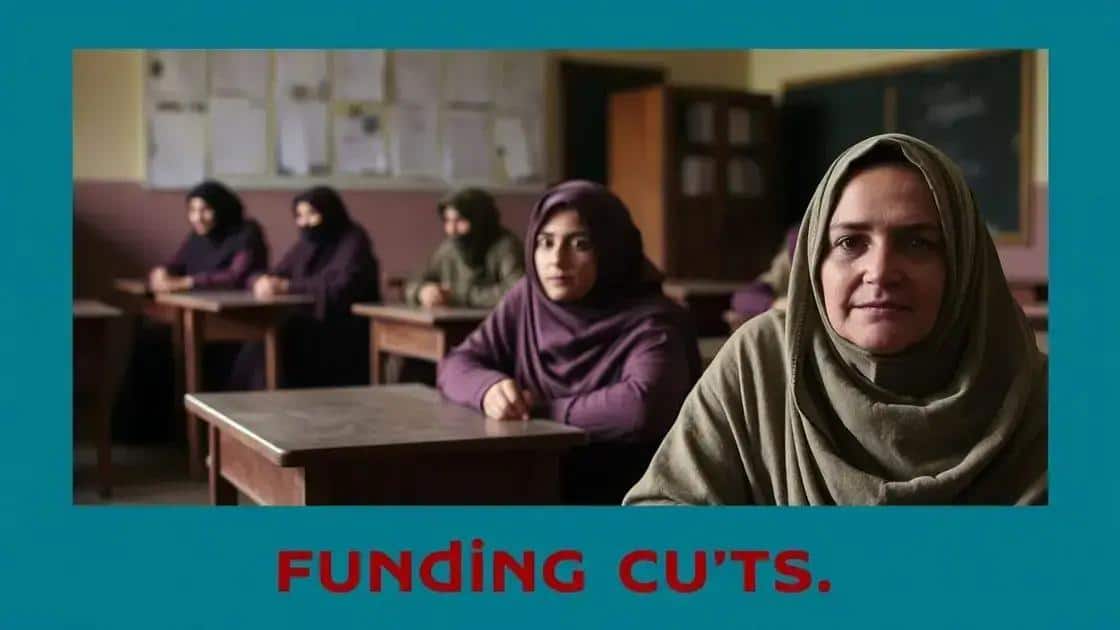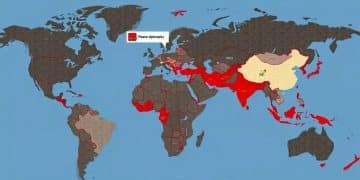Trump cuts educational funding for Afghan women studying abroad

Anúncios
Trump cuts educational funding for Afghan women studying abroad severely limit their access to education, prompting international communities and activists to advocate for support and create alternative pathways for their educational aspirations.
Trump cuts educational funding for Afghan women studying abroad has stirred significant debate about the future of education for these women. What does this mean for their opportunities and aspirations? Let’s dive into the details.
Anúncios
The history of educational funding for Afghan women
The history of educational funding for Afghan women has evolved significantly over the past few decades. With the changing political landscape in Afghanistan, the attention towards women’s education has fluctuated greatly. Early initiatives aimed to boost education for women, but challenges remain.
Major Milestones in Funding
In the early 2000s, after the fall of the Taliban, foreign aid increased drastically to support women’s rights and education. Funding came from various international organizations, aiming to rebuild and promote education.
However, these efforts faced numerous challenges, including security issues and cultural resistance.
Anúncios
- In 2001, major international efforts began to improve educational access.
- Programs were developed to provide scholarships for women students.
- Awareness campaigns highlighted the importance of women’s education.
As initiatives gained traction, more Afghan women began enrolling in educational programs, particularly in urban areas. Yet, as the landscape shifted, so did the support. During periods of political instability, funding often saw significant cuts, which directly impacted educational opportunities.
The Role of NGOs
Non-Governmental Organizations (NGOs) have played a crucial role in maintaining educational support. They have worked tirelessly to provide resources and funding.
Without these organizations, many Afghan women might not have access to basic education.
- NGOs have created programs specifically tailored for girls.
- Community awareness projects aimed at changing perceptions.
- Partnerships with local governments to ensure sustainability.
The funding provided by NGOs, paired with international support, has been essential in resisting the adverse effects of political changes on women’s education. Through resilience and advocacy, various institutions stand firm to support these vital educational initiatives.
Impact of funding cuts on Afghan women’s education

The impact of funding cuts on Afghan women’s education has been profound. As financial support diminishes, many educational programs find it hard to maintain their operations. This situation has led to a noticeable decline in opportunities for women seeking education.
Immediate Consequences
When funding is cut, the most immediate effect is felt by the students. Schools may have to close or reduce their hours, impacting the ability of women to attend classes. Furthermore, teachers could be laid off, causing a lack of qualified personnel to guide and educate these students.
- Decline in enrollment rates among women.
- Increase in dropout rates due to financial constraints.
- Limited access to quality educational resources.
As opportunities dwindle, many women may feel discouraged from pursuing their dreams. This can lead to a vicious cycle, where fewer women are educated, perpetuating the issues of inequality and limited prospects in society.
Long-Term Ramifications
The ramifications of these funding cuts go beyond individual students. When women lack education, the entire community suffers. Educated women are often key to driving economic growth and social change. They contribute to the workforce and can uplift their families and communities.
- Reduced economic participation of women.
- Decreased health and well-being in communities.
- Lower rates of civic engagement and leadership.
Without intervention and renewed support, the trend of educational marginalization could continue to deepen. As the stakes rise, advocacy for women’s education remains critical to ensure that Afghan women can access the learning opportunities they deserve.
Alternatives for Afghan women seeking education abroad
For many Afghan women, seeking educational opportunities abroad has become a viable alternative amid local challenges. Alternatives for Afghan women seeking education abroad encompass various pathways that can empower them and provide new possibilities.
Scholarship Programs
Numerous organizations offer scholarship programs specifically for Afghan women. These scholarships can make studying abroad more accessible by covering tuition and living expenses. Through these initiatives, many women have been able to pursue degrees in different fields.
- International universities often have scholarship funds dedicated to women from developing countries.
- NGOs provide financial aid and support for Afghan female students.
- Some governments offer scholarships as part of their foreign aid programs.
Scholarship opportunities can help change the lives of Afghan women, allowing them to gain valuable education in safe environments.
Online Learning Platforms
Another alternative is online learning platforms, which provide flexible education options. Many reputable universities now offer online courses that can be accessed from anywhere in the world. This method allows Afghan women to learn at their own pace while balancing their personal responsibilities.
- Various platforms offer free or affordable courses in numerous subjects.
- Online education provides access to global knowledge without leaving home.
- Networking opportunities with international peers can arise from online courses.
The flexibility of online education is crucial, especially when safety and mobility are concerns. It gives Afghan women a chance to enhance their skills without facing the risks of traveling abroad.
Collaborative Programs
Some universities facilitate collaborative programs with Afghan institutions, creating a bridge for students. These partnerships help provide exposure to international education without requiring full relocation. Such collaborative efforts can also blend local culture with educational practices.
- Joint degrees allow students to attend classes in both their country and a partner institution.
- Exchange programs can offer temporary study experiences abroad.
- Workshops and seminars can be conducted online or in-person to share knowledge and expertise.
The ability to participate in collaborative programs helps Afghan women gain international experience while still being close to their communities. These alternatives reveal the potential for Afghan women to achieve their educational goals, fostering growth and progress despite challenges.
Responses from international communities and activists

Responses from international communities and activists regarding the education of Afghan women have been varied and robust. Many organizations and individuals have stepped forward to advocate for educational rights and support programs aimed at Afghan women.
Global Advocacy Efforts
International communities have launched campaigns to raise awareness about the challenges Afghan women face. Organizations such as UNICEF and Amnesty International have been at the forefront of these efforts, emphasizing the importance of education for all, especially women.
- Advocacy groups use social media to highlight stories of Afghan women.
- Global petitions seek to gather support for educational funding.
- International conferences focus on women’s rights and education in Afghanistan.
These global efforts aim to put pressure on governments to prioritize and restore funding for educational programs in Afghanistan.
Partnerships and Funding Initiatives
Many activists have collaborated with NGOs to create funding initiatives specifically for Afghan women’s education. These partnerships aim to provide immediate financial support for schools and scholarships for students.
- Collaborations often include fundraising events and awareness campaigns.
- Programs provide resources such as books and materials to local schools.
- Scholarships help cover tuition costs for Afghan women studying abroad.
The combination of local and global efforts has helped some Afghan women continue their education despite significant obstacles.
Impact of Social Movements
Grassroots movements within Afghanistan have also gained momentum, advocating for educational rights. Women have organized protests and campaigns, demanding equal access to education. These local voices are vital in shaping policy and raising awareness internationally.
- Activists use grassroots strategies to mobilize support.
- Community leaders play a significant role in advocating for educational reforms.
- Awareness in local media helps to amplify their message.
The collective response from international communities and local activists highlights the importance of education for Afghan women. They work together to create pathways toward a better future, despite the challenges they face in a changing environment.
FAQ – Questions about Afghan Women’s Education and Support
What are the main challenges Afghan women face in education?
Afghan women face challenges like funding cuts, cultural barriers, and safety concerns that hinder their access to education.
How are international communities supporting Afghan women’s education?
International communities provide scholarships, raise awareness through campaigns, and partner with NGOs to offer educational resources.
What is the role of online learning for Afghan women?
Online learning offers flexible education options, allowing Afghan women to continue their studies while managing personal responsibilities at home.
How can grassroots movements impact education in Afghanistan?
Grassroots movements empower local activists to advocate for educational rights, mobilizing community support and pressure for policy change.






